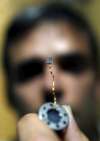This is an archived article that was published on sltrib.com in 2009, and information in the article may be outdated. It is provided only for personal research purposes and may not be reprinted.
There was a time on major university campuses when researchers toiled in the lab, wrote scientific papers, won praise from students and colleagues, and were awarded tenure. What they discovered seldom reached the public.
Then, says University of Utah entrepreneurial specialist Glenn Prestwich, campus leaders decided "we had better start companies" to get that technology into the marketplace.
"Otherwise, the stuff will just stay at the bench. We'll have brilliant publications, but nothing will change in health care."
An entrepreneurship program, with roots buried in the U.'s creation nearly three decades ago of Research Park and spurred by federal legislation in the early 1980s, produced 23 new companies in the past fiscal year -- all the result of technology developed by faculty researchers, according to Jack Brittain, U. vice president of technology venture development.
That puts the Salt Lake City-based university second in the nation, behind M.I.T., for the number of spin-offs per year, Brittain said. In the past four years, Utah has recorded an average of 21 annually; M.I.T.'s four-year average is 23.
"By creating companies and not just licensing technology, we got those companies to set down roots in Utah," he said. "Our objective: Get technology into use to make peoples' lives better and also create jobs in Utah."
The list of 23 shows a diverse blend ranging from firms that develop drug-delivery products and make highly specialized tools to those involved in new ways to deal with environmental cleanups and the development of cell-phone games.
Take, for example, Salt Lake City-based Waste Water Compliance Systems. It is developing devices -- known as the "Poo-Gloo" -- that sit in the bottom of small-community sewage lagoons and accelerate bacterial decomposition of harmful contaminants.
The firm employs six full- and part-time workers. As the product gains traction after two northern Utah test sites are evaluated, it expects to double its work force in the next year to a dozen, according to CEO Fred Jaeger.
He predicts the Poo-Gloo will go national within two years.
"This is a billion-dollar market opportunity," said Jaeger, noting there are 7,000 lagoons in North America that could use this product. Small communities use the low-cost lagoons in lieu of building multimillion-dollar sewage-treatment plants, and the Poo-Gloos, which will "only cost a few thousand dollars each," can be clustered. A 3-acre lagoon, say, might have 50 devices sitting on the bottom helping nature break down contaminants.
The start-up company, which is based on research conducted by two university science-faculty members, could not have come about without the U.'s entrepreneurship program, said Jaeger.
"I view the TCO [Technology Commercialization Office] as a partner, not just a license vendor," he said. "During these early years, they ... gave us all kinds of help."
His support for the U.'s program is echoed by another 2008-09 start-up entrepreneur , Florian Slozbacher, who directs a Research Park-based company known as Blackrock Microsystems.
The university, he said, "recognizes that if a faculty member has the right kind of skill set [to be an entrepreneur] ... they give you the tools to commercialize. And they give you credit for it in your regular work as a professor; they tie it to the tenure track."
His company, with 20 full-time employees and seven interns, is developing micro-sensors and micro-electronics for a variety of applications for the aerospace and automotive industries. It also is working on various medical monitors that measure physiological and metabolic functions.
Much of the research that ends up as the basis for private spin-offs begins thanks to federal grants and other sources of public and private money. That's why the U. retains an equity stake, said Brittain.
"As soon as there is a single dollar of external investment [in a potential spin-off], we step out of it. We get royalties and [a 3-5 percent] equity stake. Everything we make goes back to the university."
According to Prestwich, who serves as a special assistant to U. President Michael Young, it can take up to $100 million of research funding to create a start-up. He said at one extreme, the University of Washington received $1.2 billion a year in research funding and, last year, started only six or seven companies. At M.I.T., "they bring in $3 billion a year, and they started 30 companies."
"In the past three years, the U. has brought in nearly $1 billion in research money. From that federal investment, we've spun out more than 60 companies," he said. "This shows we are the most efficient in the nation at companies generated per research dollars spent."
jkeahey@sltrib.com" Target="_BLANK">jkeahey@sltrib.com
-- President Michael Young, University of Utah



